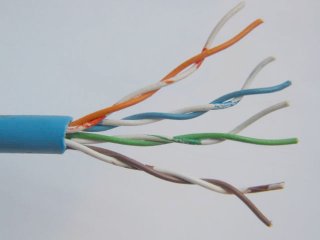
networking curriculum
support CD for senior
secondary studies
Topics
. Home
. Networking History
. Why network?
. OSI model
. Connecting up
. Protocols
. Technology
. Network types
. Topologies
. Issues
. Design factors
. Economic effects
. www links
. Site map
 networking >
connect up > 10Base-T Cat5 RJ45
networking >
connect up > 10Base-T Cat5 RJ45
10Base-T Cat5 RJ45
Cat 5 cable for data purposes is made up of 8 wires, in 4 twisted pairs. It is the most common system for connecting LAN’s over small distances.

Each pair is colour coded (one wire full colour and the other white and colour striped). There is no shielding. Any electrical interference is cancelled by the twisted pairs exposing alternative wires to similar signals and the transmitted signals sent as a differential voltage. Any interference in the pairs then cancels out.
The connector shown is an RJ45. This is a popular connector and has proven to be very effective and reliable. The pairs have to be connected in the right pattern at either end of the cable.


There are two variations on the cable connections. One is used to connect a client to a hub or a switch ("straight through" cables) and the other is used to connect down-linking hubs or switches to each other ("cross over" cables). The crossover version is often used by people to make a single cable network between two computers without using any hubs or switches. Quite handy to do some quick file transfers!
Shown is an RJ45 (8 wire) style connector for a laptop. Note the RJ11 (4 wire) is for the modem phone line connections with the USB connector alongside.

worksheets
. history
. why network
. osi model
. connecting
. protocols
. technology
. topologies (tla)
. issues
. network types
. design
. economics
. economics (cs)
- solutions -
quizzes
. why network
. osi model
. connecting
. protocols
. technology
. topology
. issues
. network types
. design
. economics
| Home |
History |
Why Network? |
OSI Model |
Connecting up |
Protocols |
Technology |
Networks Types |
Topologies |
Issues |
Design Factors |
Economic effects |
:: copyright |
credits |
sitemap ::
© 2003 Victorian Information Technology Teachers Association
http://www.vitta.org.au/
